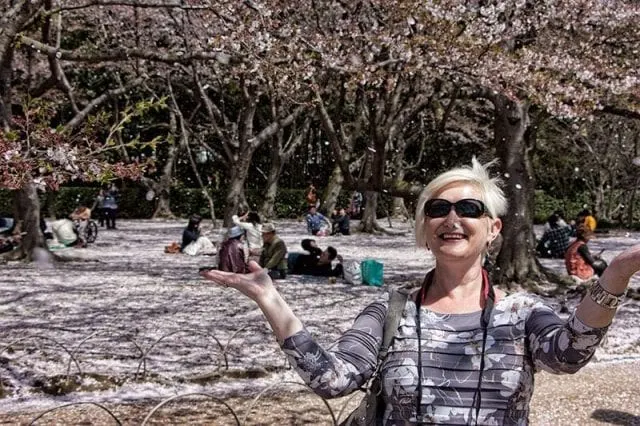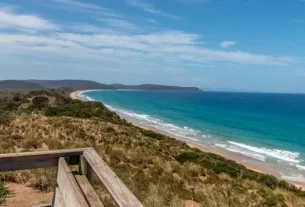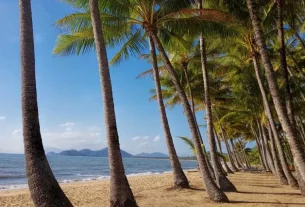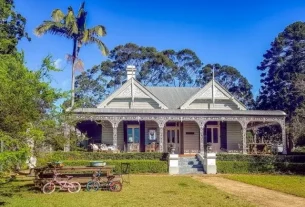Looking for an interesting cultural addition to your Japan itinerary? Our comprehensive guide will show you the best things to do in Kurashiki including where to eat, play and stay as you step back in time and wander the character-filled streets.

The Kurashiki Bikan Historial Quarter is one of the most picturesque of the heritage merchant districts in Japan. Its canal is lined with willow trees and 300-year old white-walled warehouses dating back to the Edo period. Today it has a relaxed leisurely vibe and is home to a diversity of artisans, galleries and cafes.
You can take a boat ride on the canal, wander through the museums and galleries, explore the many narrow laneways and enjoy seasonal treats in the cafes that now occupy the restored warehouses. We’ll cover many of our top things to do in Kurashiki Bikan in detail below.
The historic district is the most visited area of the city of Kurashiki. It’s a coastal city on the Seto Inland Sea at the mouth of the Takahashi River. Located in Okayama prefecture just 20 minutes from the Shinkansen station it’s easy to include as a stop when travelling between Osaka and Hiroshima or as a day trip from nearby cities such as Kyoto.
Table of Contents
History of Kurashiki Bikan
That Kurashiki Bikan Historical Quarter is a pretty heritage area is hinted at by its name. Kurashiki, the name of the city can be roughly translated to ‘a town of storehouses’ while Bikan means ‘beautiful view’. From our perspective, it’s an accurate description.
Rice has always been a staple of the Japanese diet, it stores well but is heavy and bulky to transport. During the Edo period (1603-1867) towns such as Kurashiki emerged to an important part of the distribution path for rice and came under the control of the Edo Shogunate.

The restored white-clad storehouses with the distinctive black tile trim are clustered alongside the canal. They were built with walls as much as 30cm thick to protect the precious contents from deterioration and thieves. Today you can almost feel the energy that would have been present in its heyday as ships carried the rice down the river and out to sea bound for major cities such as Osaka and Tokyo.
Getting to the Kurashiki Bikan Historical Quarter
If you are travelling along the Sanyo Shinkansen Line, that’s the one that runs between Osaka and Fukuoka on Kyushu Island via Hiroshima you will get off at Okayama station.
From here you transfer to the local train for Kurashiki which is usually on tracks 1 or 2. The trains run every 5-10 minutes and cost Y330 for the 16-18 minute trip.
There is a Kurashiki station and a Shin-Kurashiki station. A ‘Shin’ station is one that the Shinkansen or bullet trains use but it’s too far to walk from there to the Historical Quarter, you would need to catch a local train to backtrack a couple of stops to Kurashiki station.
Another reason we prefer changing to a local train at Okayama rather than Shin-Kurashiki is that it is a minor station and only the slowest of the bullet trains (Kodama) will stop there. Most shinkansen will bypass it and that will make it less flexible for you to connect through there.
Things to do in Kurashiki Bikan
Explore the Kurashiki Hondori covered shopping street

This is the most interesting way to head from the station down towards the canal and historical area of Kurashiki. Cross the road from the station and head just slightly left and you can enter the top end of the covered shopping street.
If you went right instead and around the corner, there are a couple of lanes that you can follow just down there that let you cut through to the shopping street too.
Aside from the practicality of shading you from the heat of the sun or any rain there are a variety of local shops to look at along the way from clothing stores to crafts and produce.
Take a leisurely stroll through the Kurashiki Bikan Historical Quarter
From the end of the covered shopping street, you can continue on the level path through to the historical quarter or head up the stairs to the left to the Honeiji Temple and Achi Shrine.

The heritage area is a combination of European-style architecture and traditional Japanese wooden merchant houses and white-walled warehouses called ‘kura’. These were used to store valuable resources, predominantly rice.
What we particularly enjoyed about Kurashiki was the extent of the heritage buildings, it’s not just the major lanes but wander off down the side streets and you keep discovering more. Many of them are galleries, craft stores, cafes and interesting small stores to browse through.
It’s also still off the tourist trail and very quiet making it feel even more like you’ve time travelled back in time 300-years.
Take a traditional boat ride on the Kurashiki Canal

The canal area is the heart of Kurashiki Bikan and an iconic thing to do when you are in the area is to take a boat ride on the canal in one of the traditional wooden boats.
The section of the river where the ride takes places is quite short but the fee is only Y500 and it gives an interesting perspective on the town and the picturesque bridges.
While we were there a bride and groom were also out on the river having photos taken in one of them.
Morita Sake Brewery

When you spot a cedar ball like this outside a door it means sake is served there, the balls are hung green when the batch is put down, when they turn brown it means the sake is ready to drink.
This is the Morita Sake brewery. The traditional style building blends into the pretty heritage street and you can book onto a tour here where the family business has existed for over 200 years.
Visit Ohara Museum of Art
Unfortunately, the dramatic Ohara Museum of Art was undercover for renovations when we visited which was a bit disappointing but it’s back open again now.
This classical Greek-style building made out of blocks with tall pillars at the front houses a collection of western and Oriental art, including pieces by many of the masters: Monet, Matisse, El Greco and Gauguin. It was the first museum in Japan to house a permanent exhibit of western art back in the 1930s.
What isn’t immediately obvious from the outside is how large the area is, it’s more than the main building you see from the street and the lovely garden hidden away behind it.
The museum is open from 9 am until 4.30 pm and entry costs Y1300. You can find visitor information and details about the current exhibitions here.
Take a rickshaw ride back in time

The Japanese rickshaw is still pulled by hand, one of the only places in the world where this is still the case. They aren’t something that exists in everyday life but is commonly seen in the heritage tourist areas like Arashiyama and Gion in Kyoto, Asakusa in Tokyo or on Miyajima Island in Hiroshima.
Kurashiki is the quietest area we have seen them and if you were going to give them a go the quiet lanes amongst the white-walled historic warehouse buildings would be a scenic and relaxed experience. Without the traffic, crowds or hills that many of the other locations have it would definitely be my choice.
Bizen pottery

The area is known for its many fine craftspeople but especially the distinctive Bizen pottery style. The pieces are formed from a high-quality clay and fired in a tunnel kiln unglazed with pine wood at 1250°C for 20 days. It creates a matte finish of natural subdued colours.
There are several places to see and buy the pottery in galleries around town but we particularly liked this one on the main street down to the canal. Upstairs is a cafe that serves great coffee and ‘kakigori’ a very refreshing summer treat of shaved ice served with fruit syrup and condensed milk.
Immerse in the local folklore at Momotaru Museum
The story of Momotaro or ‘peach boy’, is a well known Japanese fable that most local children will know, a bit like Hans Christian Anderson when we were growing up.
The story goes that one day a farmer was fishing in a river near his home in Kibi when he reels in a giant peach. Inside instead of a peach pit is a baby which the farmer and his wife raise as their own.
Some years later Ogres raid the village and the boy sets off with 3 of his animal friends to defeat them. The clever monkey, the loyal dog and the brave pheasant all use their individual strengths to help Momotaru defeat the Ogres by outsmarting them and make them promise to leave the villagers alone forever.
The museum features displays, tricks and sleight of the hand tricks all related to the story.
5-11 Honmachi, Kurashiki City, Okayama Prefecture
Climb up to Honeiji Temple and Achi Shrine above the town

The temple and shrine are located up above the town and offer a view out over the rooftops of the heritage part of Kurashiki below. They aren’t large but are serene and beautifully maintained.
The Buddhist temple, Honeiji, is located lower down the hillside than the Achi Shinto Shrine. The temple can be entered from below either by climbing the main central stairs that start near the heritage area or the ones that come up the side to the temple and shrine that start at the end and slightly to the left of the covered shopping street so it’s easy to incorporate into the beginning of end of your visit.
By going at the start of your visit and continuing up to Achi Shrine you will look down over the temple grounds and have quite a good perspective on the area before you start exploring.
Buy a modern parasol/umbrella

One of Japans ancient arts is the design and construction of parasols, a type of umbrella that used to be made of paper. Today we like to shelter from both the sun and the rain and they’re a practical item to have handy but local manufacturer Hokusai Graphic ensures they are also somewhat stylish.
Hokusai is a famous Japanese artist known for creating incredible dimension in a painting with only a handful of shades, most notably blue which is incorporated in many of the design.
I was due a new umbrella and after seeing the peony show the previous week in Tokyo with Tomoko following our Ueno food tour I decided on a blue design that features the flower. An unusually colourful choice for me but I love it.
Kurashiki Museum of folk craft
The Kurashiki museum of folk craft is a curated collection of items that are both useful in everyday life and pieces of art. There are some 15,000 items in the collection both old and modern. They come from Japan, around the Orient and the west.

The collection includes crafts and artisan pieces made from ceramics, glass, masonry, dyeing and weaving, woodwork, lacquerware, metalwork, braided goods, papercraft and folk paintings. Eclectic but cohesive in its theme of function meets form.
Stop by Ivy Square

This area today is a leafy complex of museums, restaurants and a hotel but it is interesting as the former site of the magistrate’s office during the Tokugawa period and from 1888 the Kurashiki Textile Company cotton mill.
The brick buildings belonged to the first modern cotton mill built in Japan and put the town at the forefront of introducing new industrial textiles techniques nationwide.
A few remnants still date back to the times of the shogun including a canal that heavily was in bloom with yellow iris while we were that that used to run through the governor office.
Kojima Jeans Street

For something quirky head to Kojima Jeans Street, it’s marked on the map below. There are many shops selling great quality Japanese and international jeans brands and jeans related items. Upcycling denim is a big thing here.
Jeans flutter overhead as an art statement and even the foodies are catered for with a variety of blue coloured icecreams keeping with the theme. Think Jeans Ice Cream, Denim Soft Cream and Indigo Soft.
Map of Kurashiki Bikan
Where to stay near Kurashiki Bikan
We visited the Kurashiki Bikan historical quarter on a day trip from our base at the Swissotel in Namba, Osaka. The hotel is directly above the subway and two train stations, not that you would know that from inside but it makes it an ideal base for the food and sights of Namba and easy access for day trips further afield like this one.
At other times in Japan we prefer a more touring based approach, still using the train network but stopping for a night or two at each destination along the way. A night at Kurashiki Bikan would be an interesting option in this case if you were moving between Hiroshima and Kyoto or Osaka.
You could stop at Kobe or Himeji castle in the morning then head through to Okayama, explore the city and famous gardens then continue on to Kurashiki Bikan in the afternoon.
The canal area is especially pretty lit up at night and there are plenty of places to eat nearby. Take a stroll in the evening or early morning when it is peaceful and calm with very few other people around.
In Kurashiki Bikan itself, our pick would be the Dormy Inn in Kurashiki. You can see on the map below how well it is located in relation to the attractions in the area, we like that it is an easy stroll out to the canal. It’s a business style hotel so the rooms aren’t large but they are clean and well maintained. A big attraction for us with this one is that there is both an indoor and outdoor onsen on top of the building for guests to use. Bliss!
Check prices and availability for Dormy Inn Kurashiki here and read reviews from guests on Trip Advisor.
Another option would be to stay near Okayama station. This would make it easy to drop suitcases at the hotel on the way through and move on to Kurashiki without being encumbered by luggage on the local train.
There are restaurants nearby and one of Japans top 3 gardens and Okayama castle are located within walking distance from the station. In this case, the Hotel Granvia Okayama is really convenient being located at the station and we have stayed in this chain around Japan and have found them to be excellent every time.
Other things to do nearby
Explore Okayama castle

Okayama castle was completed in 1597 and survived through the Meiji Revolution and into the 20th century. It wasn’t until WWII when the castle was destroyed by Allied bombers but was subsequently rebuilt in 1966.
I particularly like the ‘black crow’ style of this castle which reminds me is Matsumoto Castle in Nagano. It’s particularly special as many of the views from the garden incorporate it in their scenery.
Read more about visiting Okayama Castle here.
Korakuen Garden in Okayama
These large public gardens were established in 1687 around the adjacent Okayama castle. They are widely regarded as being one of the top 3 gardens in Japan and well-deserving of their title.

They are impressive in all seasons but perhaps especially in the spring cherry blossom when local families come and picnic beneath the trees. We were there just slightly past the peak as the petals swirled and fell in a thick fragrant carpet.
Korakuen features in our favourite gardens in Japan article and we’ve also published a guide for visitors specifically for this garden.
Cycling on the Kibi plain
If you’re interested in a more active half-day activity consider taking the train to either Bizen-Ichinomiya or Soja station and hiring a cycle at one of the bike rental shops adjacent to the station.
The train runs about every 30 minutes and takes only 12 minutes from Okayama station costing Y210. The fare is covered by the JR Pass if you are using one.
Cycling between the 2 stations is around 18 km and you can cover most of the distance s on a cycle path through the rice paddocks, detouring off to shrines, temples and historical burial mounds that are dotted around the countryside. You’ll want to allow 3-4 hours to cycle and explore the area along the way.
You might notice that the train line out here is the JR Momotaru Line and the area has a lot of Momotaro (peach boy) references as was also seen at the Momotaro Museum in Kurashiki.
Get more information on the ride or recent visitors reviews of their experience on Trip Advisor.
Final thoughts on Kurashiki Bikan Historical Quarter
With its canal backdrop, the heritage merchant district of Kurashiki is possibly the most picturesque of the old towns in Japan. Although others such as Kawagoe near Tokyo are equally interesting and can be a good alternative if you aren’t headed as far west as Okayama.
We loved the relaxed feel of the streets around Kurashiki Bikan. There are many areas around Japan that feature the restored houses, teashops and merchant buildings from the era but here you wander through street after street of them. With far fewer tourists it genuinely had the feeling of stepping back to a quieter time.
If you are feeling overwhelmed after the intensity of the big cities and mainstream tourist destinations then Kurashiki Bikan can offer a respite from that while showing another aspect of this beautiful country. Still very much Japan but a detour from the beaten path.
If you found this article useful please consider saving it to Pinterest. It makes it easy for you to find it again, it helps us, and it helps other travellers to find the information they are looking for.
If you’re considering a visit to Kurashiki and have any questions not covered here please ask, we’d be happy to answer them if we can in the comments below. If you’ve been yourself we’d love to hear your thoughts and whether you enjoyed your time here.



